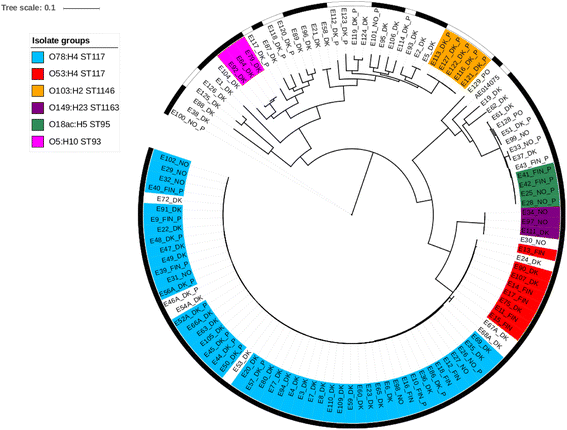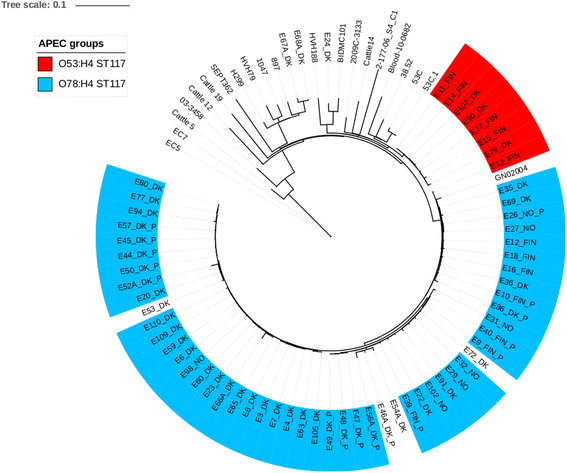Spread of avian pathogenic Escherichia coli ST117 O78:H4 in Nordic broiler production
- PMID: 28049430
- PMCID: PMC5210278
- DOI: 10.1186/s12864-016-3415-6
Spread of avian pathogenic Escherichia coli ST117 O78:H4 in Nordic broiler production
Abstract
Background: Escherichia coli infections known as colibacillosis constitute a considerable challenge to poultry farmers worldwide, in terms of decreased animal welfare and production economy. Colibacillosis is caused by avian pathogenic E. coli (APEC). APEC strains are extraintestinal pathogenic E. coli and have in general been characterized as being a genetically diverse population. In the Nordic countries, poultry farmers depend on import of Swedish broiler breeders which are part of a breeding pyramid. During 2014 to 2016, an increased occurrence of colibacillosis on Nordic broiler chicken farms was reported. The aim of this study was to investigate the genetic diversity among E. coli isolates collected on poultry farms with colibacillosis issues, using whole genome sequencing.
Methods: Hundred and fourteen bacterial isolates from both broilers and broiler breeders were whole genome sequenced. The majority of isolates were collected from poultry with colibacillosis on Nordic farms. Subsequently, comparative genomic analyses were carried out. This included in silico typing (sero- and multi-locus sequence typing), identification of virulence and resistance genes and phylogenetic analyses based on single nucleotide polymorphisms.
Results: In general, the characterized poultry isolates constituted a genetically diverse population. However, the phylogenetic analyses revealed a major clade of 47 closely related ST117 O78:H4 isolates. The isolates in this clade were collected from broiler chickens and breeders with colibacillosis in multiple Nordic countries. They clustered together with a human ST117 isolate and all carried virulence genes that previously have been associated with human uropathogenic E. coli.
Conclusions: The investigation revealed a lineage of ST117 O78:H4 isolates collected in different Nordic countries from diseased broilers and breeders. The data indicate that the closely related ST117 O78:H4 strains have been transferred vertically through the broiler breeding pyramid into distantly located farms across the Nordic countries.
Keywords: APEC; Colibacillosis; Comparative genomics; Phylogenetic analysis; Virulence factors.
Figures


References
-
- Landman WJ, van Eck JH. The incidence and economic impact of the Escherichia coli peritonitis syndrome in Dutch poultry farming. Avian Pathol. 2015;9457:1–27. - PubMed
-
- Moulin-Schouleur M, Reperant M, Laurent S, Bree A, Mignon-Grasteau S, Germon P, et al. Extraintestinal pathogenic Escherichia coli strains of avian and human origin: Link between phylogenetic relationships and common virulence patterns. J Clin Microbiol. 2007;45:3366–76. doi: 10.1128/JCM.00037-07. - DOI - PMC - PubMed
-
- Dho-moulin M, Fairbrother JM. Avian pathogenic Escherichia coli (APEC) Vet Microbiol. 1999;30:299–316. - PubMed
MeSH terms
LinkOut - more resources
Full Text Sources
Other Literature Sources
Medical

